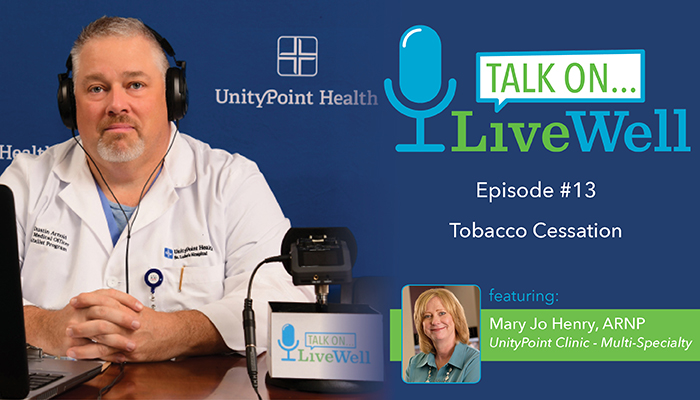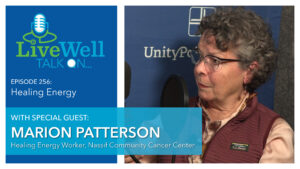Mary Jo Henry, ARNP, joins St. Luke’s Chief Medical Officer, Dr. Dustin Arnold, to discuss tobacco cessation treatment.
Subscribe on: Apple Podcasts | Google Podcasts | Spotify | iHeart Radio | Pandora | SoundCloud | Stitcher | TuneIn
Host
Dr. Dustin Arnold
Chief Medical Officer
UnityPoint Health – St. Luke’s Hospital
Guest:
Mary Jo Henry
Tobacco Treatment Specialist
UnityPoint Clinic Multi-Specialty
Transcript
Dr. Arnold: This is LiveWell Talk On…Tobacco Cessation. I’m Dr. Dustin Arnold, Chief Medical Officer at UnityPoint Health – St. Luke’s Hospital. Each year more than 480,000 people in the United States die from illnesses directly related to tobacco use. That’s one in five deaths. Tobacco use not only causes cancer, it can damage nearly every organ in the human body. Fortunately, there are various approaches to quitting for good. Here to tell us more about tobacco cessation is Mary Jo Henry, Tobacco Treatment Specialist with UnityPoint Clinic Multi-Specialty. Welcome.
Mary Jo Henry: Thank you for having me.
Dr. Arnold: You know, nicotine addiction is just, is such a horrible condition to have. Some people are more, addicted, if you will, than others. Some can easily quit, some cannot. I remember my own father, having a bilateral, below the knee amputation for peripheral vascular disease and still wanting to smoke, knowing full well that it was cigarettes that caused that, you know, so if losing your legs is not a motivation to quit, it’s hard to imagine what would be, and I know you had some experience in this for quite some time. It’s interesting that I think people underappreciate the addiction potential of nicotine, when exposed to it, you know, they think of cocaine and heroin and those are all commonly thought of as addictive substances that can be, can’y be done without in some individuals. But I think caffeine and nicotine are two that we kind of take for granted because they’re so common. What’s your approach to having a patient curtail and hopefully quit smoking?
Mary Jo Henry: Well, first of all, I almost always explain the addiction, how it works, cause I think that’s really helpful for them when they’re trying to quit. And another thing that I want them to understand the addiction is because of treatment, because of the medications we use, a lot of people are really confused when they’re wanting to quit smoking, trying to quit nicotine and I recommend that we use nicotine replacement therapy.
Dr. Arnold: Now, question, I’ve always found in my practice that there are different types of smokers. There’s some smokers, it’s something to do with their hands, truck drivers for example. It might be something to do with their hands as they drive. Other people are truly the nicotine addiction. And you do see that. So do you, do you break down kind of categorize or put your patients in specific categories or buckets to say that this is how I’m gonna approach this one? Or is it just across the board approach?
Mary Jo Henry: I think we, smokers, and maybe us as clinicians too try to do that or are we feel like, yeah, oh it’s not, I think we underestimate the nicotine addiction. Okay. I think, yeah, there is first, and I still have patients that are coming to me and they’re telling me that their doctors or their providers are telling them it is not an addiction. It’s a habit. You just quit. And that is not true. It is an addiction. It’s a very strong addiction with the habit component to it. Okay. And, so you have to get the, we all have nicotine receptors in our brain and to get through and manage the nicotine addiction that has to be addressed. And as long as you keep feeding the nicotine addiction, you’re never going to be able to break that cycle. So a lot of people there is that part, the habit part of it, but you can’t minimize the nicotine addiction. It is. And I think it’s very helpful for people. I think there is the hand, like you said, the hand mouth thing, that’s a part of every addiction, every nicotine addicted person. Some is, that’s more of it than another, you know, and no, I don’t try to break it up. What I try, how I tried to or how I break down, what approach or I’m gonna go try to help this patient is where they are in readiness to quit. Cause we all know we love someone and like your example was perfect of your father, but until he is ready, there isn’t anything anybody can do. And maybe if they aren’t physically able to go get the cigarettes, you know, that’s one way.
Dr. Arnold: Correct, yeah. There’s always an enabler somewhere with most addictions. But yeah. Do you have, I mean, what is your first step after you’ve had that conversation, whether or not they’re ready to quit or not, Are there patients out there that can just quit cold Turkey?
Mary Jo Henry: There are, but that’s the-
Dr. Arnold: What percentage?
Mary Jo Henry: I don’t know a percentage I’m sorry. Dr. Arnold, but I think that is the exception.
Dr. Arnold: You could’ve made up something. I would have believed it.
Mary Jo Henry: I’m not very good at thinking on my feet.
Dr. Arnold: Okay, no that’s fine, Mary. That’s why we love you because you’re nice and honest. So what was the first step you, first of all, you get them to look at cigarettes and nicotine as an addiction to a substance.
Mary Jo Henry: And that it should be considered a disease like any other. Diabetes or COPD. And it’s a treatment plan. We said we’d get a treatment plan together and then stick to it. It’s different because there is behavior modification. We all know that it’s hard to change and get people to change their ways. I have my training, I received my tobacco treatment specialist through Mayo Clinic and their approach is using motivational interviewing and I don’t claim to be an all out expert in motivational interviewing. It basically, what it comes down to is helping the patient find their reasons and their motivation for wanting to quit and if they’re not there yet, giving them some things to think about. So when they are ready, they have a little bit of a head start. They have some tools in their toolbox to get started.
Dr. Arnold: What percentage of the patients that you work with are there all already motivated? They’re like “I’m here today because I want to quit smoking.” What percentage are like, my wife made me come or my doctor made me come.
Mary Jo Henry: Well, we’re trying to do a better job of screening out those. Not that it’s not that it can’t be beneficial. Like I said, I tried to plant some, some thoughts in their mind and give them something to think about. If they’re not ready. So that’s gotten better. And I would say probably it’s a rough guess, but 75% are ready.
Dr. Arnold: Are ready. Motivated. What, what is the most, I’m sure all motivations individualized. You know, and I admit that freely, but is it the financial costs, the health risks, the lack of socialization?
Mary Jo Henry: Those are all big, very big factors and very common in a lot of people. Health and the cost. And even if people aren’t having health consequences yet or noticeable health consequences. If you figure out if a pack a day smoker at a little over $6 a pack for an average cigarette, we’re talking about $2,500 a year.
Dr. Arnold: Yeah, there’s a guy in front of me, the convenience store the other day and he bought a pack of cigarettes. It was like seven something, you know, and it was like, oh my God. My dad used to give me a $10 bill and he’d call up to the handyman and I’d ride my bike up there and I’d buy a pack, a carton of Old Gold filters. And it was like $9 and change, and then what was left over, I got to buy candy with, you know, and then I’d ride it back home to him. And then I was just thinking, this guy just throws down, you know, a $10 bill and it gets, you know, just a small amount of money back for one pack.
Mary Jo Henry: Right. And as with any addiction, when you’re actively addicted, you’re minimizing that. I mean, you just, there isn’t, it doesn’t matter how much it’s going to cost, you need to have that, you want to have that. And people who can afford that financially, they put it out of their mind. I mean, they just don’t think about it or they try not to. And so bringing that to the forefront and start saying, what are you, what would you do with that money? So to help them get motivated, I bring that to light, and help them figure out how much they’re actually spending in cigarettes and then when they’re, and what would you start? What would you use that money for? What would- start thinking about that. And then when they’re actually cutting down or quitting or have quit, putting that money away, putting it in a jar or putting it separately in a separate account and really see how much, how quickly that’s adding up. And to use when they meet maybe their first milestone or their second milestone. So they haven’t smoked for a month, take some of that money and reward, reward yourself for the hard work. It’s hard work to quit smoking. It’s much easier to keep smoking and so take that reward yourself and our pocketbooks are a pretty good motivator for us.
Dr. Arnold: Yeah, absolutely. Yeah, it’s interesting how things have changed. You know, it used to be that the non-smoking section of a restaurant was a card table in the back of the, you know, the storage room and the nice section was the smoking section and that, so that certainly has changed. I had a patient one time, she was in the Navy and other sailors would go up deck to have a smoke break and then she went up once and she wasn’t a smoker and you know, she was reprimanded. You can’t just come up here, you know, but it was okay to go up and smoke. So she started smoking so she’d get these breaks, you know, and then help work with her with when Welbutrin came out for that way back when to get off that. But one of the things I used to do, and I do not have near the experience that you have in, in assisting people with quitting cigarettes, I would give him the talk about this drug and I’d say, okay, so, how many cigarettes a day do you smoke? I smoke 20. I’d say, okay, we’re going to go down one cigarette every three days until we were done. You know, I used to tell them that if it’s 10:00 PM at night and you were supposed to smoke seven cigarettes that day and you’d only smoke five, I said, you got to sit on the edge of bed and smoke those two back to back. You have to think of it more as a chemical that you’re getting on your system and you had to titrate off. And that was really successful for some people. Some people didn’t work at all.
Mary Jo Henry: Right. And that’s why each quit plan is individualized. Absolutely has to be. Nicotine. The receptors in the brain get used to how much nicotine they’re given, okay. And so, if you decrease that, slowly, it can be a little bit less painful, less nicotine withdrawal symptoms. Okay. And some people there, they want, they set a quit date and they want to quit by then and that’s when they want to do and that, that works for them. And there’s other people and I find that most of them, especially long-term smokers, prefer the reduce to quit method.
Dr. Arnold: Titrate off, curtail back over your time
Mary Jo Henry: And using any of the medicines, almost double their chance of being successful.
Dr. Arnold: You mentioned nicotine addiction, excuse me, nicotine withdrawal symptoms. Can you tell me what some of those are?
Mary Jo Henry: Irritability, difficulty concentrating, nervousness. Less common or less known ones are, constipation. ‘cause nicotine is a stimulant. Oh, there are all kinds of them.
Dr. Arnold: And how long did they last?
Mary Jo Henry: One of the techniques that I use a lot and recommend with my patients, is I ask them, do they realize that that urge to smoke is gonna go away whether they have a cigarette or not? And some of them do, but some of them, some of them, that is a completely a thought that they had never thought of before. And so I say that comes to your mind. Say, okay, I would like a cigarette but I’m not going to act on it for at least 10 minutes. And then get busy. Do something, that distracts your mind from thinking about that cigarette and that thought will, and it works. The thought will come back. Okay. If you can delay it again, another 10 minutes, do that. But, you know, the thought comes back, okay, now I’ll, I’ll have a cigarette. So, I think, it’s minutes, that the feeling is there and that urge to smoke, but it will go away. It will go away. In a matter of minutes it’ll come back. And the more you don’t act on that the longer it is before that thought comes back again. And another helpful technique for the hand mouth thing is having people talk to them about stimulating those motions of smoking without actually smoking. So using an object that kind of looks or feels like a cigarette, a lot of like-a straw, a cut straw, is something that-
Dr. Arnold: Well, we can’t have those ‘cause of sea turtles though. So that’s gonna-
Mary Jo Henry: Oh yeah, that’s true. Yes. Well, paper ones, I guess we can have paper ones now. Yeah. And so when they delayed as long as they can and now they’re going to have a cigarette, then when they’re reaching, instead of reaching for the cigarette, you reach for the straw and you put it to your mouth. Like you know, you do when, when you’re smoking, simulate that inhalation, hold, hold it. And then along deep breath out. And that’s very similar to the inhaling of the cigarette. So they’re, they get that feeling of the lungs filling up, but with air, rather than the harmful smoke from the cigarette and then that, that deep breathing, that purposeful, slowing down the breathing and taking the deep breath also helps with the nicotine withdrawal symptoms by calming, calming them down.
Dr. Arnold: The gum, and the patch. How do those fit into your treatment?
Mary Jo Henry: It’s my, it’s probably what I use the most.
Dr. Arnold: Which is? The gum or the patch or..?
Mary Jo Henry: Together. Then my recommendation, unless there’s a compelling reason why you can’t use one or the other is to use a combination of long and short acting, nicotine replacement. So the patch takes the edge off of the nicotine withdrawal symptoms. And so, but there’s still the habit part. And so using the gum or the lozenges when they’re having that urge, helping them delay and start to figure out what am I going to do instead of smoking. What am I going to do to replace this, the time and activity of smoking. And so the patch takes the edge off and then the nicotine, the short acting nicotine replacement gives them that, pulse of nicotine to help them through the really strong urges so that they can focus their energy on behavior changing and reducing their triggers.
Dr. Arnold: So a stick of gum, nicotine gum, is equal to how many cigarettes?
Mary Jo Henry: Well, the ones that I know anyway, there may be sticks but they’re, it’s not sticks. It’s, little squares and maybe a little tabs. And they come in two and four milligrams. And if you’re using them on, without the nicotine patch, then I use the four milligram. If you’re using it in conjunction with the nicotine patch, two milligram, but my experience is that they’re very similar in cost. So, I just have people buy the four milligrams and break them in half.
Dr. Arnold: Okay, well that makes sense. So, let me get this. So if the patches are 21, 14 and 7.
Mary Jo Henry: And that’s based on how much you smoke.
So what, what is that? What’s 21 is equal to how many packs a day?
Mary Jo Henry: One pack a day. And I don’t know that I, I wouldn’t say, I don’t know that it’s equal to, but that is, maybe it is, I hadn’t thought about it in that way, but that if someone is smoking a pack a day, if we use a 21 milligram patch, we should be able to satisfy or calm those nicotine receptors. Okay. And, a lot of times people will tell me, “Well, I’ve tried that and it didn’t work for me.” Well, how much do you, how much do you smoke? “Two packs a day.” What patch did you wear? “Oh, well, sometimes even 14 milligram or 21 milligram, but it’s not enough. Even the 21 milligram isn’t enough.” And most prescribers, not that you need a prescription, you don’t need a prescription for nicotine replacement, it’s over the counter. But people, health care providers are people who, patients turn to, to help them quit smoking, aren’t comfortable saying you need to be wearing two patches, if they’re smoking between 30 and 40 cigarettes a day, it’s 35 milligrams or even up to 20 or 48 milligrams.
Dr. Arnold: So two patches. And you just put on two 24s and to make 48. All right, that’s good. Clinical parole there. The pills, the various formulations of a Wellbutrin, have been marketed for nicotine. Tell us about that. How does that fit into your practice?
Mary Jo Henry: I use it. I use it quite a bit. And I, as I can tell you with the nicotine replacement and also Varenicline, Chantix, I can tell you the exact mechanism how those work. We don’t know exactly how Wellbutrin or bupropion does help. We think it has to do with that dopamine response that you get from smoking the cigarette, that when you inhale a cigarette, smoking a cigarette is the most efficient way to get the nicotine to your brain. It happens in less than a minute, usually about 30 seconds that that nicotine is at the receptor and that dopamine is being released. Okay. So, we think that that has, that bupropion works somewhere in that pathway with the dopamine. What we do know for sure is that studies show that people who are trying to quit cold turkey, not using any medicines versus using the bupropion, the Wellbutrin, they had a higher success rate.
Dr. Arnold: So it truly is a tapestry woven together for each patient, ‘cause it’s so unique
Mary Jo Henry: Absolutely, in the real world, you know, cost is an issue
Dr. Arnold: More so than ever. Just in general in healthcare, more so than ever.
Mary Jo Henry: Right, yeah. And you know, the studies have shown, so Varenicline or Chantix is the first medication that was ever developed to help people quit smoking. That came out in the 90s. And our research shows that it is the most effective, has a highest success rate, but it’s also the most expensive and it also has the potential for most side effects. Okay. But the research also shows that using the combination of the long and short acting nicotine replacement almost reaches that of the, varenicline. And there’s less side effects.
Dr. Arnold: The benefit is not smoking’s worth trying these different mechanisms and keep trying. You know, I don’t think you’re never-
Mary Jo Henry: The varenicline, I’d just like to say how that works. It gets in, it sits on the nicotine receptor in the brain so that the nicotine cannot get there. And so they’re not getting the positive or the dopamine response each time that they smoke a cigarette. So there’s not that chemical reinforcement to keep doing it.
Dr. Arnold: It gives them some pleasure from it.
Mary Jo Henry: They get less pleasure.
Dr. Arnold: Less pressure prevents them from dopamine release. That makes sense.
Mary Jo Henry: And a lot of times they will tell me that the cigarettes don’t taste as good when they’re taking the Chantix
Dr. Arnold: Yeah. I like old time radio shows, I like listen to them and you know, sometimes they’ll have the commercials on there, you know, they’ll say 9 out of 10 doctors recommend this cigarette for your asthma. And I always used to, when I was in high school and played fast-pitch softball, you’d see these older guys that smoke, they’d run a first base, they’d start hacking and coughing to the dugout. They take a drag off a cigarette and their cough would go away. And I used to think that was so weird. And then when I was in medical school and you learn that well, there’s scopolamine and atropine in cigarettes, tobacco, you know, as part of the, it causes their bronchial tubes to get bigger, and than it totally makes sense that, you know, that short term relief that people get with their smokers cough in the morning with a drag of a cigarette, it is the benefits. So, you know, fortunately doctors aren’t recommending cigarettes anymore, which is all for the better. One last question. How did you get involved with the nicotine aspect of multi-specialty practice? I know this has been, your efforts, have complimented the pulmonology groups a mission for a long time, but how did you end up with, did you miss a meeting? That’s what happens to me. I miss a meeting and then I get a new assignment.
Mary Jo Henry: Nope.
Dr. Arnold: So that didn’t happen. Okay.
Mary Jo Henry: It was a conscious decision. Like I said, my career started in my nursing career, started with the pulmonary patient and a big component of that was, COPD and smokers and there was and still is, a lot of judgment. And they feel, especially nowadays, I mean, people know, that smoking isn’t good for you. There’s a lot of guilt involved with it. And that hampers their ability to, they get so caught up in that they can’t focus their time and energy on trying to quit and they feel, like it’s hopeless. I tried it and I couldn’t, I can’t do it. So that’s it. And I was a smoker. I mean, I know firsthand how hard it is. And I knew I shouldn’t be smoking. I knew all of the bad effects. I, you know, was obviously a closet smoker and hid it and I felt terrible about it. So I just felt, it was, it’s a passion for me. I am so happy that I am not a smoker anymore and I want to help other people.
Dr. Arnold: Well, that’s awesome, Mary Jo, really great information. Thank you so much for taking the time out of your busy pulmonary practice to, visit about this important subject. Again, that was Mary Joe Henry Tobacco Specialist, a Tobacco Treatment Specialist with Unity Point Clinic multi-specialty. For more information, visit unitypoint.org. If you have a topic you’d like to suggest for our Live Well Talk On… podcast, shoot us an email at stlukescr@unitypoint.org and we encourage you to tell your family, friends, neighbors about our podcast. Until next time, be well.







